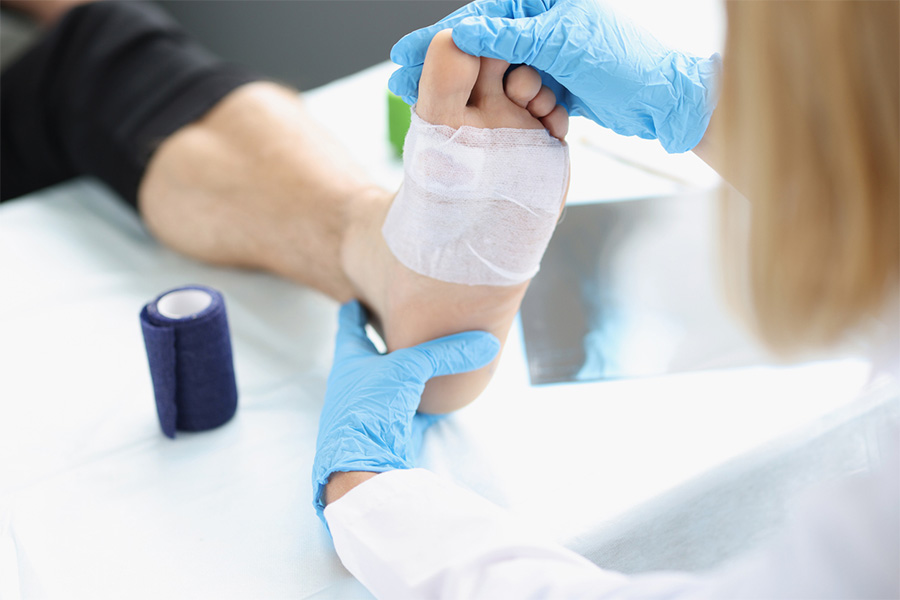How can you cope with the pain, swelling, and limited mobility associated with a foot injury? They’re common, particularly in athletic pursuits both amateur and professional. What follows are brief descriptions of common foot injuries and how you and your foot and ankle doctor can deal with them.
Reasons for Foot Injuries
People injure their feet and ankles through a variety of circumstances. Many foot injuries, particularly athletic injuries, happen due to high impact, sudden stopping, turning, or starting, and repetitive motions such as jumping and bouncing. However, even a simple wrong step off a curb or wearing cheap shoes can cause the pain, swelling and deformity characteristic of an acute or chronic foot health problem.
Other contributing factors include:
- Inadequate stretching and warm-ups before training
- Carrying too much body weight
- Previous foot and ankle sprains, strains, and fractures
- Diabetes mellitus and other chronic health conditions which impair circulation and nerve function in the feet
Your podiatrist at your foot and ankle clinic can determine the causes for your foot injury and create a treatment plan to help you cope. Prevention of injury is a big part of what foot doctors do to keep their patients healthy and moving.
The Top Four Foot Injuries and How to Cope with Them
Sprains And Strains
Foot and ankle sprains top the list of common orthopedic injuries. They involve the overstretching or tearing of ligaments which connect bones. Strains affect the tendons, which are the connectors between muscles and bones.
The first and best way to cope with foot sprains and strains is the RICE method: rest, ice, compression with an elastic bandage, and elevation of the limb above the level of the heart. When these interventions do not stop the pain, swelling, and limited mobility of sprains and strains, see your podiatrist for digital imaging and a treatment plan.
Treatment often includes simple bracing, pain meds, crutches, or a walking boot. Severe or repeated sprains or strains, particularly in the ankle, may need surgery to stabilize or reattach ligaments and tendons.
Achilles Tendonitis
This is a condition characterized by painful inflammation and swelling associated with the tough cord connecting the calf muscle to the heel. Achilles tendonitis usually responds well to the RICE protocol, but more severe cases may need cortisone injections, crutches, or a walking boot to take pressure off the tendon.
Achilles tendonitis often affects people who play sports which involve a lot of running and jumping. So, training and activity modification are key to controlling this painful problem.
Plantar Fasciitis
A soft tissue injury involving the wide band of connective tissue between the toes and the heel bone, plantar fasciitis causes substantial pain and swelling along the arch of the foot. Being overweight, walking barefoot, wearing poorly supportive shoes, and running too much can cause a flare-up.
So, activity modification is a must, along with:
- Calf stretches before running
- Wearing shoe inserts
- Using a night splint to keep the affected ankle at a beneficial 90 degrees as you sleep
- Cortisone shots to reduce swelling
- Extracorporeal pulse activation technology, or application of low energy sound waves to speed healing
Heel Spurs
Heel spurs are small bony projections which develop on the arch-side of the heel bone and can be very painful. They typically develop with plantar fasciitis or Achilles tendonitis. Heel spurs cause sharp, stabbing pain when a person walks or runs.
While many spurs respond well to rest, ice and elevation of the foot, others may eventually need surgical revision. Physical therapy and custom-crafted orthotics help prevent and treat bone spurs, too.
Foot and Ankle Specialists Who Treat Sports Injuries in the Foot
For superior care of and education on foot injuries, look no further than our exceptional board-certified podiatrists who understand both acute injuries and chronic conditions of the lower extremities. You’ll find state of the art diagnostics, treatments, and follow up care which gets you back to your day-to-day life without pain.
To learn more about what Cincinnati Foot and Ankle Care offers at our 18 locations, please find our location nearest you to arrange a consultation. Additionally, you can request your visit here. We look forward to serving your podiatric needs!





